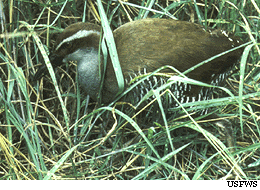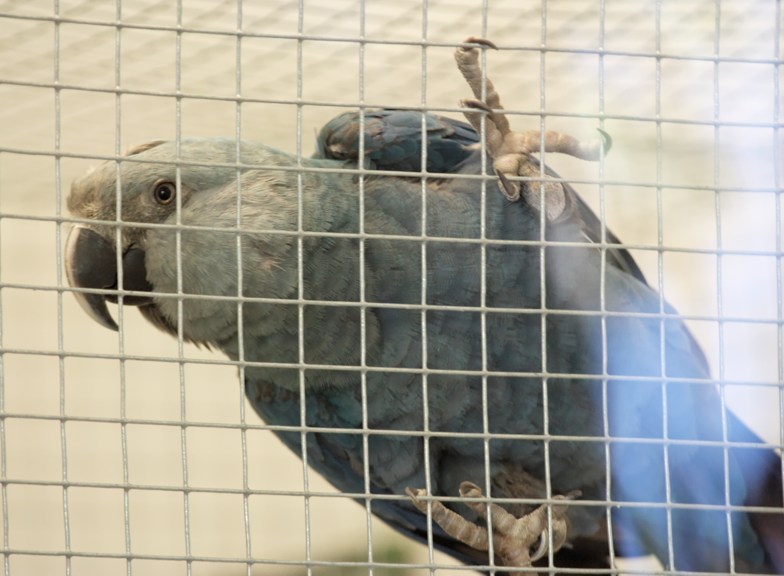Bird extinctions, especially those on islands, are usually caused by introduced mammalian predators – most often cats and rats – and hunting. The sad story of the virtual disappearance of all birds from Guam is unique in that a reptile, the Brown Tree Snake, is at its root.
The Brown Tree Snake arrived on Guam in the late 1940’s as a stowaway (from the Admiralty Islands) in supplies used to repair the damages wrought by World War II. Finding a paradise of ample food and no predators, populations of this unusually adaptable snake soon exploded. Today 8 of Guam’s 12 forest dwelling bird species are extinct, 2 survive only in captivity or semi-captivity, and 2 are on the brink of extinction.
The Guam Rail, Gallirallus owstoni, became extinct in the wild in 1987. In 1984, while working at the Bronx Zoo, I received several pairs from a group held in captivity on Guam. They were a mazingly aggressive little birds, and bred readily. Today they thrive in zoos and have been released onto Guam’s neighboring island, Rota. The Micronesian Kingfisher, Halcyon cinnamomina, also holds on in captivity but is gone from the wild. These have proven more difficult than the rails – those I worked with fed well but remained edgy and usually failed to breed. Captives that do reproduce often make poor parents, and hand rearing of the chicks is sometimes necessary.
mazingly aggressive little birds, and bred readily. Today they thrive in zoos and have been released onto Guam’s neighboring island, Rota. The Micronesian Kingfisher, Halcyon cinnamomina, also holds on in captivity but is gone from the wild. These have proven more difficult than the rails – those I worked with fed well but remained edgy and usually failed to breed. Captives that do reproduce often make poor parents, and hand rearing of the chicks is sometimes necessary.
The bird extinctions have wrecked havoc on the ecology of local forests. Nearly 70% of Guam’s trees rely upon birds for seed dispersal or to aid in germination by removing seed coats via the action of their digestive systems. Recent tests reveal that all seeds of most trees on Guam fall directly below the parent, where lack of sunlight and high levels of seed-predators condemns them to certain death.
Lacking birds, the snakes have now turned their attention to fruit bats, rodents, shrews and lizards, with catastrophic consequences – Guam’s endemic fruit bat and 5 lizards species are gone, and introduced house mice and rats are the only rodents observed in recent years. People have been bitten while sleeping (it is theorized that the snakes strike at rapid eye movements – how’s that for a “rude awakening”!?) and bird owners sometimes find a stuffed snake in a cage that formerly held their pet.
and introduced house mice and rats are the only rodents observed in recent years. People have been bitten while sleeping (it is theorized that the snakes strike at rapid eye movements – how’s that for a “rude awakening”!?) and bird owners sometimes find a stuffed snake in a cage that formerly held their pet.
The birds of mainland USA are not without problems – nearly 25% of our species are considered to be at risk, and the recent introduction of Burmese Pythons to south Florida does not bode well for birds there.
The Brown Tree Snake is considered a potential threat to Hawaii’s unique and already fragile bird populations as well. Read more about this story at:
http://query.nytimes.com/gst/fullpage.html?res=9E0CE7D61239F937A25754C0A964958260&sec=&spon=&pagewanted=2
Guam Rail image is referenced from Wikipedia Commons at http://en.wikipedia.org/wiki/Image:Guam_rail.gif and originally posted by Sabine’s Sunbird
Brown Tree Snake Image is referenced from Wikipedia Commons at http://en.wikipedia.org/wiki/Image:Brown_tree_snake_Boiga_irregularis_USGS_Photograph.sized.jpg and was originally posted by Onionhound
 That Bird Blog – Bird Care and History for Pet Birds
That Bird Blog – Bird Care and History for Pet Birds

 considered by many ornithologists (biologists who study birds) to be the most intelligent of the world’s 9,000+ bird species. People have apparently held this view from the earliest of times, as the folktales and legends of many races are filled with tales attributing great powers and cunning ways to these impressive birds.
considered by many ornithologists (biologists who study birds) to be the most intelligent of the world’s 9,000+ bird species. People have apparently held this view from the earliest of times, as the folktales and legends of many races are filled with tales attributing great powers and cunning ways to these impressive birds. of the extinction of the USA’s only native breeding parrot, the Carolina Parakeet, Conuropsis carolinensis. The last known specimen of this species died in 1918, in the Cincinnati Zoo. However, a spectacular, pigeon-sized parrot once frequented the mountains of southern Arizona and New Mexico, gorging on pine cones before migrating south to breed.
of the extinction of the USA’s only native breeding parrot, the Carolina Parakeet, Conuropsis carolinensis. The last known specimen of this species died in 1918, in the Cincinnati Zoo. However, a spectacular, pigeon-sized parrot once frequented the mountains of southern Arizona and New Mexico, gorging on pine cones before migrating south to breed. A test that enables technicians to positively identify the virus has also been developed. Birds afflicted with PDD are often misdiagnosed, due the overlap of the symptoms with a number of other diseases. It is believed that the test will assist in monitoring and limiting the spread of PDD, an extremely important step given that a cure still eludes us.
A test that enables technicians to positively identify the virus has also been developed. Birds afflicted with PDD are often misdiagnosed, due the overlap of the symptoms with a number of other diseases. It is believed that the test will assist in monitoring and limiting the spread of PDD, an extremely important step given that a cure still eludes us.